Megan Davies interview
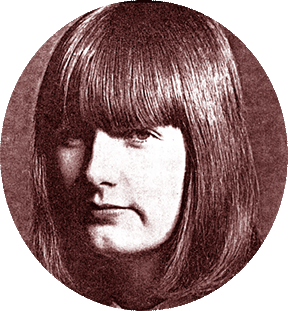
In 1964 Birmingham had its first group in the Top Ten. Their follow-up release was given to them by The Beatles! They made a film!! They appeared at the incredible NME Poll Winners concert!!!
Just one of these claims would be enough to satisfy the ego of any musician. Over the short period of two years 1964/65 all these events were experienced by The Applejacks. From the release of their first single "Tell Me When" they were hot property, with much of the publicity surrounding the group aimed at the fact they possessed a female bass player namely, Megan Davies.
Mystery BrumBeat personality Bulls Head Bob asked Megan for her early memories of starting out as a bass player and what guitars she opted for along the way;
My Guitars... for the love of Freda
When I say I started from "rock bottom" there is no innuendo. My first guitar was as low as one can go i.e. a plastic, four string 'Skiffle' guitar from Woollies which I received on my 11th birthday. It came with a gadget which could be hooked over the neck and covered the first four frets, it was held on with a heavy duty elastic band. The device sported four buttons, which when depressed would hold down the individual notes of a complete chord. No tangled fingering for me!
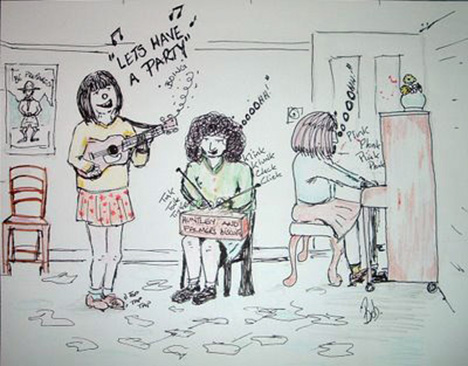
A couple of friends and I had a so called 'group'. I don't think we ever selected a name but we had lots of ideas! Margaret Griffiths, a lifelong friend, played the piano and her friend, Anne Abernethy, who lived across the road, improvised on 'drums' with knitting needles and biscuit tins. I proudly twanged away on my plastic strings! We just rehearsed a lot but were really a "sitting room group". We considered "Let's Have A Party" to be our best number.
That damn guitar would never stay in tune and I broke at least one string at every rehearsal so for the next couple of years Margaret and I stuck to singing and acting with our local drama group. I would mess about at home on the piano and "encourage" my sister, Marina, to dance to my compositions.
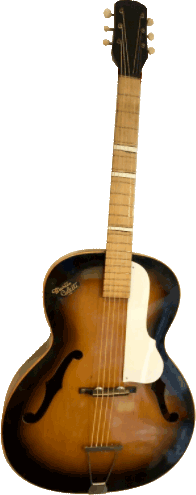
My father, in an effort to support my musical cravings, bought me a "Martin Colletti" six string guitar with 'F' holes, when I was fourteen. I still struggled with chord shapes (today, little is known about Colletti guitars other than they sound Italian but were made in Czechoslovakia in small numbers).
The Scouting movement was a big feature of my upbringing. Dad was a Scout Master and mum, a Guide Captain. At the age of fifteen, I moved from Girl Guides to assist with Wolf Cubs and in 1960, the 1st Olton Scout Group were preparing a Gang Show and when asked "Can anyone play an instrument?" a few of us took up the challenge. Martin Baggott, Phil Cash and I possessed guitars and Gerry Freeman was the obvious choice as the drummer because he was the lead drummer in the Scout band.
We all got together to perform a couple of skiffle numbers, "Hang Down Your Head, Tom Dooley" and "John Henry". Thus from a little wooden hut in Jubilee Park, Olton, Solihull emerged the "core" of The Applejacks. A local Youth Officer came to see one of the Gang Shows and asked us to play at a few Solihull venues.
Hands up those who want to play bass?
Cliff and The Shadows was definitely the way to go. There were very few other role models to choose from anyway, and we gradually went electric. It was obvious then, that one of us would have to change to bass guitar. Here, I think the story goes, "Well, you're the worst guitarist, Megan. You can play bass." I'm not sure that it was actually said in so many words, but that's the gist of how I got the job.
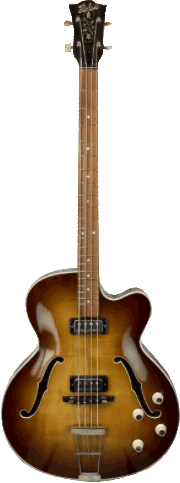
My first bass was a sort of sunburst but more of a brown Hofner President Bass Guitar. 'Hire Purchase' was a new phenomenon in the UK which now enabled you to buy expensive goods on a monthly payment basis but you needed someone over 21 to countersign the agreement. My dad acted as guarantor. I used to visit Kay Westworth's in Cherry Street, every month to pay my seven shillings and sixpence (40 pence in today's money).
The amps at the time were those Leak/Grampian/Linear 'clone' basic amplifiers that had a metal cage casing, through which you could see the glowing valves. The valves were always coming loose. I'm not sure they were meant for so much travelling. I remember browsing for accompanying speakers in the Radio Spares shop which was situated in the Great Western Arcade in Birmingham. Speaker cabinets were made by various fathers who were also often commandeered as roadies or managers. When Martin got his first Watkins Dominator we thought we had arrived.

Solid body guitars were now becoming more freely available in the shops and although there was little choice, Dallas, Hofner, Burns or Watkins, they were more colourful and fashionable than the bulky semi-acoustics we had been using and one by one we progressed to Hofner V guitars in RED! Maybe it was The Shadows influence or our scouting background that seemed to make us think uniformly. The boys wore red ties to match their guitars and I had a sort of rosette of red ribbon. We thought we looked special but now I look back upon those decisions with extreme embarrassment!
The solid body Hofners were an improvement, at least image-wise for a while but the dream of the majority of guitarists was to own a Fender. The year was 1962 and Selmer had just started distributing the Fender range of guitars (Stratocasters were 163 guineas new). "Monk" Mutch (Johnny Neal and The Starliners) let me use his Fender bass at one of John Singer's Town Hall gigs and I was smitten (by the bass and Monk's playing).

Martin was the first to buy a Stratocaster. The occasion was so memorable. He acquired the guitar on Thursday and was knocked off his bike on Friday. With a broken left arm, he was still determined to play for the All Saints' Hospital Social Club gig that evening. With his arm in a cast he winced his way through Apache, Kon Tiki, Frightened City - the lot. What a trooper!
I couldn't wait to change my guitar and I bought my first Sunburst Fender Jazz Bass from Jack Woodroffe's. The difference between my previous Hofner and the Fender Jazz was beyond comparison. The notes were cleaner and warmer, the whole balance of the guitar was different and was enhanced even further by the contoured shaping of the guitar body that fitted snugly, into your own body shape. The neck felt perfect in my hand and of course - the beautifully finished Sunburst effect of the early Fenders has never been equalled. Once again, I would visit the shop to pay my monthly hire purchase instalment. This was the instrument that I used on "Tell Me When".
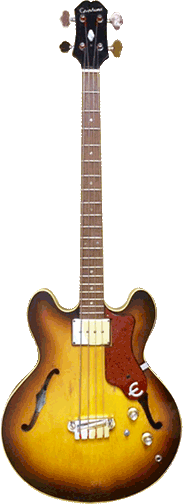
We were later to move to the Gibson 335 Stereo guitars and I used a matching Epiphone Rivoli Bass - all in sunburst. I don't know what finally persuaded me to switch to the Epiphone but I seem to remember getting it for a price that I couldn't refuse plus, it was a new design and very much in fashion!
I did try out a Gretsch Bass for a week or two which is featured on a major Applejacks/Dezo Hoffman photo session. I managed three numbers on stage with it before my left arm nearly fell off with the strain of the weight. Such imbalance in a guitar was crazy.
I bought "Freda" at Manny's in New York City
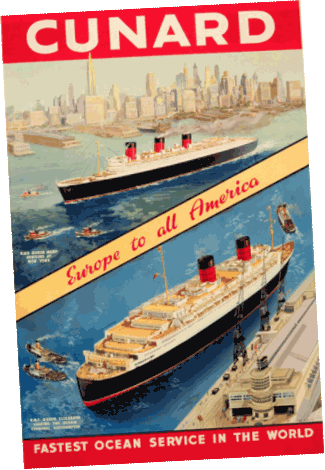
The pop music scene was very fresh in those days with no real expectations of longevity. George Harrison famously said that he expected the Beatles to "last for four years". We had by 1966, made our way into the financially lucrative Ocean Liner cabaret runs on the RMS Queen Mary, RMS Queen Elizabeth and RMS Queen Elizabeth II.
The only downside to this is that we became pretty much isolated as pop artists and out of touch with the local and national music scene. Nevertheless, those three years at sea were great fun. We saw some wonderful jazz musicians in New York where we docked every two weeks during the summer.
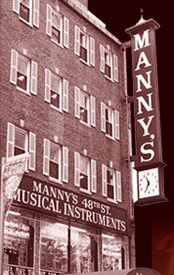
I had stuck with the Epiphone for three years and again I'll never know why I left it so long to get back to a Fender Jazz but I did. In 1967, I bought Freda (girl's thing - naming a guitar) at Manny's in New York City. This time I paid in cash and the price was £80 including a hard case. I remember that it was almost £80 just for the case in England! I took the big chrome plated "F" bridge cover off, as was the custom, because I kept catching my fingers and I sometimes like to play close to the bridge.
We were cruising at the time and would spend a few days in freezing temperatures in New York followed by excruciating heat in the Bahamas, Bermuda or the West Indies. The fret board couldn't take it and the pearl inlays sank into the wood due to its contracting and expanding. I complained but they wouldn't give me a new bass at Manny's. They repaired it by packing each inlay and you can still see the little bits of wood used to support some of them.
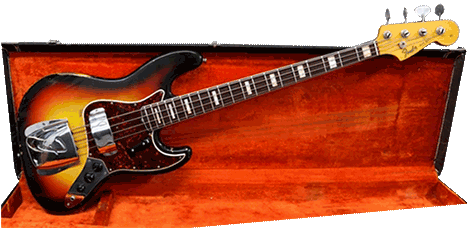
That's really the end of my changing guitar story. Freda has been with me ever since. Apart from the time that she was stolen!! It was at a gig at "The Junction" pub in Harborne (Birmingham) with Stuart Scott and Mickey Barker in 1974. We had finished playing and I had put Freda into her case in the dressing room and returned to the stage to get the gear down. When I went back to the room, I picked up the case and immediately realised that it was empty.
It's every musician's worst nightmare! I probably cried (girl's thing). For the next few days the word went out to all the local bands and someone came up with a name. I am indebted to Stuart Scott, who did the detective work, and I remember driving around a particular road in Harborne and retrieving Freda from a hedge in someone's front garden, where the thief had unceremoniously chosen to dump her. Some of the paint had cracked on her back but otherwise she was in one piece.
I was so happy, only a musician can appreciate the feeling of getting a loved guitar back. Nowadays she has a few bald patches and a tell tale burn by the machine head next to the nut where I used to put my cigarette! Apart from string changes, a new nut in 1979 when I was doing eight sessions a week with Ivy Benson plus two refrets (by Bob Barry) she hasn't changed at all. I have had no pickup problems in 40 years.
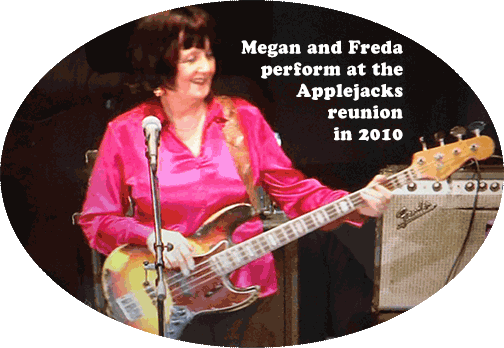
these days...
I guess I could ramble on for ages about gigs and groups from the 60s onwards. I still do a few gigs but not in the professional sense. Got involved with a musician so one of us had to get a proper job! I have a good position in the NHS at the National Hospital for Neurology and Neurosurgery, Queen Square, London. I miss my music.
Megan Davies
Copyright © 2007 Megan Davies
Illustration Copyright © Bulls Head Bob
See also The Applejacks
Back to "IN THE SNUG"